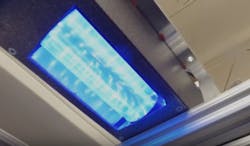Low-dose-rate excimer lamps in hospitals, schools, and airports could safely curtail spread of flu (watch video)
Continuous low doses of far-ultraviolet C (far-UVC) light can kill airborne flu viruses without harming human tissues, according to a new study at the Center for Radiological Research at Columbia University Irving Medical Center (CUIMC; New York, NY). The findings suggest that use of overhead far-UVC light in hospitals, doctors' offices, schools, airports, airplanes, and other public spaces could provide a powerful check on seasonal influenza epidemics, as well as influenza pandemics.
Scientists have known for decades that broad-spectrum UVC light, which has a wavelength of between 200 to 400 nm), is highly effective at killing bacteria and viruses by destroying the molecular bonds that hold their DNA together. This conventional UV light is routinely used to decontaminate surgical equipment.
"Unfortunately, conventional germicidal UV light is also a human health hazard and can lead to skin cancer and cataracts, which prevents its use in public spaces," says study leader David J. Brenner.
RELATED: Narrow-spectrum UV light at 207 nm may reduce surgical infections
RELATED: E-lamp emits ultraviolet simply
RELATED: Cold-cathode field-emission VUV lamp is cool and compact
Several years ago, Brenner and his colleagues hypothesized that far-UVC could kill microbes without damaging healthy tissue. "Far-UVC light has a very limited range and cannot penetrate through the outer dead-cell layer of human skin or the tear layer in the eye, so it’s not a human health hazard. But because viruses and bacteria are much smaller than human cells, far-UVC light can reach their DNA and kill them," said Brenner.
Excimer lamp sources
Brenner and his group use filtered excimer lamps emitting in the 207 to 222 nm wavelength range. For example, 207 nm light is emitted by a krypton-bromine (Kr-Br) excimer lamp, while 222 nm is emitted by a krypton-chlorine (Kr-Cl) excimer lamp. Brenner's group started with the 207 nm lamp, publishing results on sterilization of bacteria in 2013;1 in 2017, the results at 222 nm for bacteria were reported.2 The latest results, on sterilization of the influenza virus, were published this month (Feb. 2018) in Scientific Reports.3
(Video by Columbia University Irving Medical Center)
The latest study showed that far-UVC at 222 nm inactivates more than 95% of airborne aerosolized H1N1 influenza viruses at a low dose of 2 mJ/cm2. Because light at wavelengths from 207 to 222 nm are completely absorbed by the dead outer layer of skin and by the outer tear layer of the eye, these wavelengths are safe for humans (unlike the commonly used 254 nm germicidal wavelength which can cause skin cancers, including deadly melanoma).
As a result, continuous very low-dose-rate far-UVC light could be integrated into overhead lamps for hospitals, schools, airports, and so on -- potentially drastically reducing influenza. As a bonus, UVC light could prevent the spread of microbial diseases such as tuberculosis.
"If our results are confirmed in other settings, it follows that the use of overhead low-level far-UVC light in public locations would be a safe and efficient method for limiting the transmission and spread of airborne-mediated microbial diseases, such as influenza and tuberculosis," Brenner says.
At a price of less than $1000 per lamp, a cost that would likely decrease if the lamps were mass produced, far-UVC lights are relatively inexpensive. "And unlike flu vaccines, far-UVC is likely to be effective against all airborne microbes, even newly emerging strains," Brenner adds.
Sources:
http://newsroom.cumc.columbia.edu/blog/2018/02/09/uv-light-fight-spread-influenza/
http://www.columbia.edu/~djb3/Far%20UVC.html
REFERENCES:
1. Manuela Buonanno et al., PLOS One (2013); freely available online at http://www.columbia.edu/~djb3/papers/207-nm%20UV%20Light%20-%20A%20Promising%20Tool%20for%20Safe%20Low-Cost.pdf
2. Manuela Buonanno et al., Radiation Research (2017); https://doi.org/10.1667/RR0010CC.1
3. David Welch et al., Scientific Reports (2018); doi:10.1038/s41598-018-21058-w

John Wallace | Senior Technical Editor (1998-2022)
John Wallace was with Laser Focus World for nearly 25 years, retiring in late June 2022. He obtained a bachelor's degree in mechanical engineering and physics at Rutgers University and a master's in optical engineering at the University of Rochester. Before becoming an editor, John worked as an engineer at RCA, Exxon, Eastman Kodak, and GCA Corporation.
